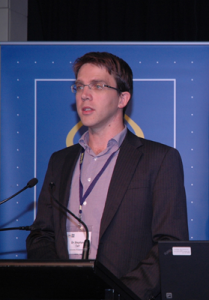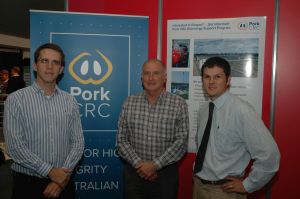Dr Navid Moheimani
Murdoch University

4A-106: Growth, development and use of algae grown on untreated and undiluted anaerobic digestion piggery effluent treating priggery anaerobic digestate using microalgae
4A-107: Bioprospecting and growth of macroalgae on anaerobic digestion piggery effluent
Navid Nailing Algae
Dr Navid Moheimani is a senior algae technical specialist with more than 14 years’ experience as an applied phycologist involved in biomass production from microalgae.
Navid was awarded his PhD 10 years ago from Murdoch University in Western Australia, for work on capturing carbon dioxide using microalgae. In mid-2006, Navid joined Biofuel Pty Ltd as Chief Scientist, working with them in Melbourne until returning to Murdoch University in December 2008 to work in large-scale algae culture for biofuel production as a senior postdoctoral fellow on the Asia Pacific Partnership (APP) on Clean Development and Climate project “Integrated large-scale microalgae culture for biofuel production”. He led the biology team. This project was successfully completed in December 2012.
Murdoch position
In April 2010, Navid was employed as a Senior Lecturer by Murdoch University. Between 2001 and 2013, Navid worked closely with his mentor Emeritus Professor Michael Borowitzka. Upon Michael’s retirement in early 2013, Navid started leading Murdoch University Algae R&D Centre.
Using algae for treating wastewater is one of Navid’s main research interests. One wastewater treatment system which is gaining acceptance in Australian piggeries is anaerobic digestion ponds. These systems typically consist of a covered pond containing wastewater which is biologically treated by heterotrophic microorganisms in the absence of oxygen. The piggery anaerobic effluent is very high in ammonium, making it unsuitable for many purposes.
Pork project
Navid was a part of the team working on Pork CRC project 4A-101112, ‘Algae for energy and feed: A wastewater solution. A review’. This review recommended that, along with anaerobic digestion, microalgae culture systems should be investigated further as a potential component of the Australian piggery wastewater management strategy.
In 2013, Navid supervised Jeremy Ayre (Pork CRC funded Honours student) investigating microalgae culture for post anaerobic digestion effluent of piggery wastewater treatment. Jeremy managed to isolate at least three microalgae capable of growing on undiluted, sand-filtered, anaerobic digestion effluent. This proof-of-concept study clearly illustrated the potential for culturing microalgae in such effluent with a high ammonium content. As a follow up to this Honours study, Navid is currently leading Pork CRC project 4A-106 ‘Growth, development and use of algae grown on untreated and undiluted anaerobic digestion piggery effluent treating priggery anaerobic digestate using microalgae’. The main aims of this project are sustainable cultivation of microalgae on undiluted and non-treated piggery anaerobic digestion effluent and to study the limits to the growth of isolated microalgae.
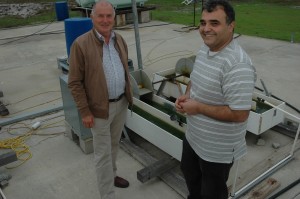 Pig feed
Pig feed
Navid and his team will also analyse nutrient composition of produced biomass and test its suitability as a feed ingredient for pigs. If the biomass is not suitable as a pig feed, they will also test co-anaerobic digestion of produced biomass with piggery effluent with the aim to produce bio-methane. Last but not least, the economics and CO2 biosequestration of large scale production will be assessed. Further to investigating potential use of microalgae for treating piggery anaerobic digestion effluent, they will also investigate the potential use of macroalgae for treating this effluent. Navid received a Pork CRC innovation grant (4A-107) ‘Bioprospecting and growth of macroalgae on anaerobic digestion piggery effluent’.
These projects are multidisciplinary, involving experts with different backgrounds. Navid’s Murdoch University colleagues Professor John Pluske, Emeritus Professor Michael Borowitzka and Dr John Huisman are contributing their expertise in nutrient studies, algal cultivation and economics and macroalgal bioprospecting, respectively. Dr Sasha Jenkins from University of Western Australia is helping to investigate the anaerobic digestion process, while Jeremy Ayre is conducting his Pork CRC supported PhD mainly on microalgae cultivation aspects of the project. The project is also supported by the Department of Agriculture and Food Western Australia and University of Melbourne (Dr Peter Cakebread).
Wastewater treatment is not Navid’s only field of interest. He has also been involved in and led several national and international projects on studying calcification, biology, photo-physiology and limits to the growth of microalgae from laboratory to large scale, both with industry and academia. For more than a decade Navid has been developing large scale cultivation systems for microalgae species isolation, adaptation, growth optimisation, increasing productivity of target species, and downstream processing. Recently, Navid has successfully built an international multidisciplinary team developing efficient hybrid conversion of solar energy to biomass, and electricity and non-destructive hydrocarbon extraction from microalgae.
Please contact Dr Navid Moheimani, if you need more information about his current studies at Murdoch University and his Pork CRC projects.
First published in APN June 2015
Prof Damien Batstone
The University of Queensland
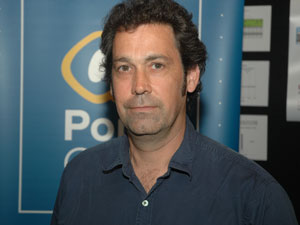
4C-105: Assessing Stimulation and Inhibition of Anaerobic Lagoons
Cover Up and Capture Carbon
Pork CRC Project 4C-105 project proposes to enable better lagoon start-up, management, and operation by avoiding costly failure and achieving better effluent quality.
Covered anaerobic lagoons are a key component of low carbon pork production, enabling methane emitted during treatment of manure effluent representing one of the easiest ways to reduce carbon emissions, as well as a method to generate renewable electricity or heat for on-site consumption.
This is because the by-product from anaerobic (without supplied air) treatment represents a potent greenhouse gas (some 22 times that of CO2), as well as a combustible fuel that can be used directly in electricity generation engines and standard gas hot water systems.
Prompt payback
Capturing it for energy generation therefore makes a lot of sense and payback periods of less than two years can be achieved, based on credits for capturing methane and the value of the energy itself. This does not include other possible benefits related to the reduced carbon footprint of the product itself and the potential ability to gain a level of energy self-sufficiency.
The lagoons themselves rely on self-sustaining complex biology to generate methane from organic wastes. This is well understood scientifically, but when problems occur on the farm, it can be difficult to interpret. Of particular concern is the potential for additives in the feed, such as antibiotics, to cause downstream problems. A critical issue historically has been the lack of tools and simple tests needed to predict and diagnose problems. This project is intended to address these issues, but developing a simple protocol that can firstly diagnose whether the biology in a lagoon is in good health and secondly indicate whether a specific chemical is likely to cause problems with operation by inhibition of the biology.
Three phase
Previously this type of testing has been much specialised, costing thousands of dollars. The project itself had three phases, including conceptual development of a simple, rapid, relatively low-cost test (in the order of $250), evaluation of this on a number of lagoon samples and testing of known inhibitors and additives. The project has now been successfully completed and the Pork CRC has submitted a provisional patent based on the test method. We are now looking at providing the specification to commercial labs for them to provide commercially. Our centre will now provide access to the test method commercially.
Technically, an important outcome was that while the test could detect and quantify inhibition caused by sodium and ammonium, a commonly used antibiotic sulfathiazole was not found to cause inhibition, largely because of a robust community and biological factors.
Strong group
The Advanced Water Management Centre at The University of Queensland leads a strong group in intensive animal wastewater treatment and management, focusing particularly on pigs, led by Prof Damien Batstone and Pork CRC Fellow Dr Stephan Tait. They are actively researching methods to improve effluent management, with a particular focus on next generation treatment methods that can lead to lower farm costs and improved profitability. This has led to practical support in effluent management systems through the Bioenergy Knowledge Centre, as well as good scientific outcomes.
The group was established by Damien Batstone. Prof Batstone received his PhD in industrial wastewater treatment from The University of Queensland in 2001 and spent five years working in Denmark and Sweden, including on effluent management systems and centralised anaerobic digestion in Denmark. Following this, he returned to establish a group in Australia at The University of Queensland in 2006. Work in Denmark translated directly to solving problems with the pig industry in Australia and Damien has worked across a range of piggery industries, including solid manures, effluent systems, and engineered digesters, generally in partnership with Stephan Tait. A key future focus will be next generation effluent systems, which look at efficiently capturing the resources in effluent, including energy, water, and fertilisers.
Prof Batstone is also Project Leader of Pork CRC Project 4C-109: Enhanced methane production from pig manure in covered lagoons and digesters, which applies results from 4C-105, as well as other international research, to achieve better practical lagoon management.
Contact: Prof Damien Batstone, Email d.batstone@awmc.uq.edu.au
First published in APN Feb 2015
Stephan Tait
Advanced Water Management Centre, University of Queensland
Projects 4C-104/105/109/110/111/113: Biogas Research Projects
Tait talk fluent in effluent
A Pork CRC project leader in Subprogram 4C, Carbon-Neutral Pork Production, Dr Stephan Tait is a Research Fellow at the Advanced Water Management Centre, University of Queensland, Brisbane, Australia.
Stephan completed his PhD in chemical engineering at University of Queensland in 2007, in the area of Industrial Enzyme Purification. After this he turned to wastewater and for four years provided project and commissioning support for wastewater treatment systems around Australia and for six months in Hong Kong. Much of this work was done with GHD Pty Ltd., a global engineering and environmental consulting firm.
Chartered professional
In 2010, Stephan became a chartered professional engineer with the Institution of Chemical Engineers for his practical engineering experience in wastewater. In 2011 he was appointed a Research Fellow at University of Queensland to coordinate an international group of experts across Europe, USA, Canada and Australia, to capture and translate chemistry knowledge into computer simulation models of wastewater treatment. Such models are used by engineers to design and troubleshoot full-scale wastewater treatment plants around the globe. This was an initiative of the International Water Association.
Stephan first joined the pork industry in 2009, when he tested spent piggery litter to biogas at lab-scale (APL project). He found that straw-based bedding produced a reasonable amount of biogas, but it took four years to secure further funding to upscale to small demonstration scale.
In 2013, Pork CRC project 4C-111 secured co-funding from the Australian Government Department of Agriculture, Australian Egg Corporation and Quantum Power, under the National Agriculture Manure Management Consortium led by APL. This project now tests spent litter to biogas at 100-200L scale and is developing low-cost technology options for medium-size piggeries.
BSP program
In 2012, Pork CRC established the Bioenergy Support Program (BSP) to support the momentum building around biogas in the pork industry. Stephan was appointed coordinator of the BSP efforts and for 18 months or so travelled around Australia and New Zealand to promote biogas as an economical option to meet a major portion (>30%) of the pork industry’s energy demand. During this period, the role of the BSP was diverse. Work with government departments refined the Carbon Farming Initiative methods which led to approximately $950,000 worth of income for the pork industry. Work with state-based gas-safety regulators paved the way for more practical safety requirements for biogas on-farm. The multitude of practical learnings-to-date by early-adopter producers have been captured and communicated to the broader industry as case study talks and now in the form of Talking Topic booklets.
Effluent Steve
Stephan was appropriately re-named by producers Effluent Steve during the Pork CRC/SARDI Pig Science Course (A definite highlight! Highly recommend it! Thank you Paul Hughes). The BSP only works because of the tireless effort of amazing people such as Janine Price, Alan Skerman, Hugh Payne, Eugene McGahan, Rob Wilson, Sasha Jenkins, Stephan Heubeck and the many producers who willingly share their essential experiences.
Black gold
Originally intended to achieve core Pork CRC research milestones, the BSP is now transitioning into targeted research to further value-add to biogas at piggeries. As also intended, this research is well informed by a clear understanding of what the pork industry needs. The Masters research project by Alan Skerman under 4C-104 is testing low-cost scrubbing materials for cleaning hydrogen sulphide from biogas. Research projects 4C-105 and 4C-109 determine tolerant levels of inhibitors (such as antibiotics and salinity) for covered lagoons and digesters and investigates the ability of pig manure derived microbes to adapt to inhibitory conditions. Project 4C-105 has led to a provisional patent for an inhibition test method. Project 4C-111 is the spent litter project named above. Upcoming Project 4C-113 targets boosting biogas production by co-digesting pig manure with other wastes such as waste by-products. This can be essential at many piggeries where the amount of biogas is insufficient to meet onsite energy demands. The project researches the positive or negative effects of mixed waste digestion. Interestingly, it is the experience (in industry and in the lab) that some wastes produce more biogas when co-digested with pig manure than if digested by themselves. Good on you Pig Manure! I always knew it was black gold!
Triple treat
The cash leveraging in Project 4C-113, Project 4C-111 and other outcomes to date from the BSP has more than tripled the value of the original investment by the pork industry/Pork CRC. Into the future, the draft plan is to provide longevity to the technical support of the BSP by transitioning the support role onto Alan Skerman at DAFF, QLD. Alan has been, for many years, actively serving the pork industry for biogas and other matters and is a Masters research student under 4C-104.
For more information on the BSP or the research described, please contact Stephan at s.tait@uq.edu.au.
First published APN Oct 2014
Stephen Wiedemann
FSA Consulting, Toowoomba, Queensland
Pictured at the launch of the Pork CRC’s Bioenergy Support Program at the Pan Pacific Pork Expo 2012 were (L to R): Dr Stephan Tait, University of Queensland, Dr Rob Wilson, Leader, Pork CRC Program 4 ‘Carbon conscious nutrient inputs and outputs’ and Steve Wiedemann, FSA Consulting, Toowoomba, Queensland.
4C-101: Life cycle assessment of waste treatment and additional pork supply chains
4C-107: Potential Pathways to Carbon Neutrality.
CRC tracks carbon and water footprint
Steve Wiedemann has led two projects in Pork CRC’s Program four, ‘Carbon conscious nutrient inputs and outputs’, focussing on quantifying and reducing greenhouse gas emissions, energy and water use, together with researchers Eugene McGahan and Caoilinn Murphy from FSA Consulting.
Carbon and water footprinting, or life cycle assessment (LCA), was new to the pig industry when we received the first project funding from APL and RIRDC in 2009. We were very pleased to see this work underpin Program 4 of the CRC, which integrates LCA as a method for identifying research targets and demonstrating continuous improvement in the industry.
CRC research
The first project was an expanded benchmarking project studying life cycle greenhouse gas (GHG) emissions, energy and water use from 13 piggeries in Queensland, NSW and WA. The study, covering 23,000 sow places, showed GHG emissions ranging from 5.0 ± 0.7 kg CO2-e/kg to 8.7 ± 1.2 kg CO2-e/kg Retail Pork, with the range in values mainly driven by differences in the manure management systems. Conventional piggeries (effluent treated in open, anaerobic ponds) generate the highest emissions, while deep litter and outdoor piggeries are estimated to generate lower emissions because manure management emissions are lower from these piggeries.
Greenhouse gases in conventional piggeries mainly arose from effluent treatment (contributing 62-64% of total emissions), with feed production (i.e. grain farming) contributing 18-40% of total emissions. On-farm energy was a fairly small contributor to GHG for most piggeries.
Managing manure
Another aspect of the research was an analysis of alternative manure management systems, with several scenarios investigated to determine opportunities for GHG mitigation and increased energy efficiency for pork production. These included pond covering to capture methane from effluent treatment and using alternative housing for breeding and grow-out stages of production. Installing a covered anaerobic pond (CAP), with combined heat and power generation (CHP), reduced full supply chain GHG emissions by 55% for pork from a large conventional piggery and reduced embodied energy by 30%. Installing a CAP and flare system reduced GHG by 46%.
Modelling future piggery systems to reduce emissions from pork systems was the focus of a second Pork CRC project, which looked at methods to reduce the whole of system emissions, finding that optimising diet and effluent systems was the best option for reducing emissions in piggeries where a CAP-CHP was installed. Modelling suggested emissions could be reduced by a further 70% by combining all possible mitigation options.
Effluent effects
These studies identified effluent ponds as the single largest emission source from piggeries. Covering the primary effluent pond at a conventional piggery will reduce emissions by some 50% and installing a generator to use this methane will reduce emissions further and cut whole supply chain energy use by 30%.
Future options to reduce emissions also exist and these will need to focus on sourcing feed inputs that have a lower ‘GHG burden’ and improved effluent handling to reduce emissions and make better use of the valuable crop nutrients in effluent and solid manure.
Steve’s status
A senior agricultural scientist specialising in carbon, water and nutrient management in the agri-food sector, Steve Wiedemann’s research includes a number of ‘Australian first’ LCA studies of the environmental impact and resource use for livestock systems, including pork, beef, lamb, eggs and chicken meat. Steve works with FSA Consulting and is based in Toowoomba, Queensland. He has a Bachelor of Rural Science (1st Class Hons) from University of New England, NSW.
Contact: Steve Wiedemann, email Stephen.wiedemann@fsaconsulting.net
First published in APN June 2014
Jae Kim, DAFWA
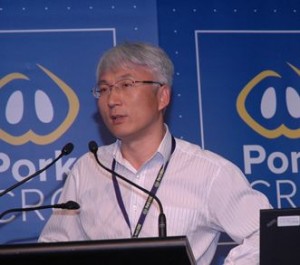
Pork CRC Project 4B-110: Further development of a reactive lysine NIR calibration for soybean meal
A Pork CRC project leader in Subprogram 4B Enhanced use of traditional protein and energy sources, Jae Kim is a research officer at the Department of Agriculture and Food Western Australia (DAFWA) and an Adjunct Senior Lecturer in the School of Veterinary and Life Sciences at Murdoch University, WA.
Jae commenced his animal science career by completing his BSc (Animal Science) degree in 1990 at Chungnam National University, South Korea. He then spent about four years in the local feed processing industry, gaining considerable industry experience, before returning to university. Before completing his MSc (Nutritional Science) degree at Massey University, New Zealand in 1999, he was partly investigating the Premium Grains for Livestock Industry Program with Professor John Pluske.
He came to Australia in 1999 and obtained his PhD from Murdoch University in 2004. Before being appointed a Research Officer at DAFWA, he received post-doctoral training at Murdoch University until 2005. At DAFWA Jae does diverse nutrition research, including energy and amino acid utilisation efficiency, role of non-starch polysaccharides and protein on clinical expression of haemolytic post-weaning diarrhoea and the role of nutrition for chronic immune system activation.
Rapid screening
Jae’s research in the Pork CRC Project 4B-110 focused on developing a rapid screening tool for protein quality in soybean meal (SBM) and soy protein concentrate, using Near-Infrared-Spectroscopy (NIR). Oilseed meals such as SBM have been scrutinised recently because heat processing during the oil extraction process severely decreases bioavailability of lysine, the most important amino acid. Bioavailable lysine (reactive lysine) refers to lysine available for body protein deposition after digestion and absorption in the small intestine. The problem the pig industry currently has in evaluating protein quality is that laboratory techniques to measure reactive lysine content in a protein meal are too complicated, time consuming and expensive. Therefore, the possibility of developing a NIR calibration that offers a fast, economic and robust test of reactive lysine was investigated.
Analysing lysine
Until this project was initiated, there was no Australian laboratory analysing reactive lysine content and samples had been sent overseas for analysis. DAFWA biochemistry team started from scratch and successfully established reactive lysine analysis using the homoarginine technique in the Animal Health Laboratory, DAFWA. This is an important development as the bioavailability of lysine in heat treated protein ingredients can now be tested within Australia at significantly lower cost and in a shorter time than previously possible.
The earlier Pork CRC Project 1B-112: Quantification of the variability in the amino acid and reactive lysine content of soybean meal and development of a NIR calibration for rapid prediction of reactive lysine content then established a NIR calibration for reactive lysine in soybean meal samples. The project initially collected 216 samples from the major SBM producing countries, including USA, Brazil, Argentina, China and India. There was a 27% variation in reactive lysine content (21.9 g – 30.1 g/kg as is basis) across all samples and 13% variation within shipment samples, suggesting wide variation in reactive lysine content in SBM samples and the use of spot-sampling to analyse reactive lysine content can be a dangerous practice. The first version of the calibration was established but had a weak predictability for reactive lysine content in soybean meal.
Stronger prediction
Therefore, Pork CRC Project 4B-110 was initiated to strengthen the predictability of the existing SBM reactive lysine NIR calibration to the level applicable for robust and reliable measurement of reactive lysine content. This project collected 93 additional samples of SBM and soy protein concentrate to further extend the range of calibration. Based on 309 samples from 1B-112 and 4B-110, a NIR calibration was established. The updated calibration predicts total and reactive lysine with the standard error of cross validations of ±1.02 g/kg and ±0.96 g/kg (as is basis), respectively, with R2 of 0.94 and 0.95. These values mean that the total and reactive lysine contents of unknown soybean samples should be predicted with 95% confidence to be within 2.04 and 1.92 g/kg of the actual value.
Clearer calibration
As not all reactive lysine in a soybean meal are digested and absorbed in the small intestine of pigs, additional calibrations were established to predict standardised ileal digestible (SID) reactive lysine content, which is the reactive lysine ultimately available for protein deposition. The linear regression equations developed from the previous in vivo experiment (Pork CRC Project 1B-112) where standardised ileal digestibility was determined in growing pigs after feeding a range of heat damaged soybean meal were used for regression of SID reactive lysine in the 309 samples. Based on these data, a calibration for prediction of SID reactive lysine was established with a similar accuracy. Therefore, the version two calibration can now predict reactive lysine content and ileal digestible reactive lysine content in SBM and soy protein concentrate in one scan and more accurately.
Project leader
Dr Jae Kim also leads Pork CRC Project 4B-120: Commercial validation study for sulphur amino acid (SAA) requirement in finisher pigs and 2C-110: Dietary manipulation of the pro-inflammatory cascade to minimise impacts on production and health indices in weaner pigs experimentally infected with an enterotoxigenic strain of E. coli.
Contact Dr Jae Kim, email jae.kim@agric.wa.gov.au
First published in APN Feb 2014




